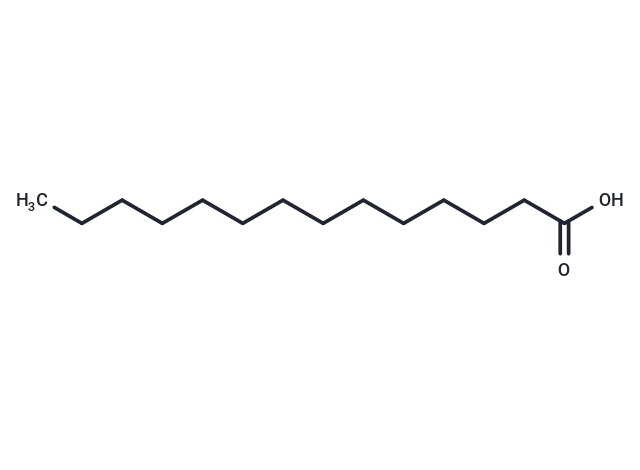 Your shopping cart is currently empty
Your shopping cart is currently empty

Myristic acid (Crodacid) , a 14 carbon saturated fatty acid, is a rare molecule in cells and is a substrate of some fatty acid desaturases. This compound has the ability to acylate proteins by covalently binding to the N-terminal glycine residues, in a process called N-terminal myristoylation. Myristoylation of substrate proteins by this fatty acid has the potential to activate and mediate many physiological pathways. Furthermore, saturated fatty acids have been reported to be essential for biological activities of lipopolysaccharides and have demonstrated the ability to induce expression of COX-2 and NFκB (nuclear factor κB) activation.

| Pack Size | Price | USA Warehouse | Global Warehouse | Quantity |
|---|---|---|---|---|
| 500 mg | $39 | In Stock | In Stock | |
| 1 g | $47 | In Stock | In Stock | |
| 1 mL x 10 mM (in DMSO) | $43 | In Stock | In Stock |
| Description | Myristic acid (Crodacid) , a 14 carbon saturated fatty acid, is a rare molecule in cells and is a substrate of some fatty acid desaturases. This compound has the ability to acylate proteins by covalently binding to the N-terminal glycine residues, in a process called N-terminal myristoylation. Myristoylation of substrate proteins by this fatty acid has the potential to activate and mediate many physiological pathways. Furthermore, saturated fatty acids have been reported to be essential for biological activities of lipopolysaccharides and have demonstrated the ability to induce expression of COX-2 and NFκB (nuclear factor κB) activation. |
| Synonyms | Tetradecanoic acid, n-Tetradecanoic acid, Crodacid |
| Molecular Weight | 228.37 |
| Formula | C14H28O2 |
| Cas No. | 544-63-8 |
| Smiles | CCCCCCCCCCCCCC(O)=O |
| Relative Density. | 0.898 g/cm3 |
| Storage | Powder: -20°C for 3 years | In solvent: -80°C for 1 year | Shipping with blue ice/Shipping at ambient temperature. | |||||||||||||||||||||||||||||||||||
| Solubility Information | DMSO: 252.5 mg/mL (1105.66 mM), Sonication is recommended. | |||||||||||||||||||||||||||||||||||
Solution Preparation Table | ||||||||||||||||||||||||||||||||||||
DMSO
| ||||||||||||||||||||||||||||||||||||
| Size | Quantity | Unit Price | Amount | Operation |
|---|

Copyright © 2015-2025 TargetMol Chemicals Inc. All Rights Reserved.